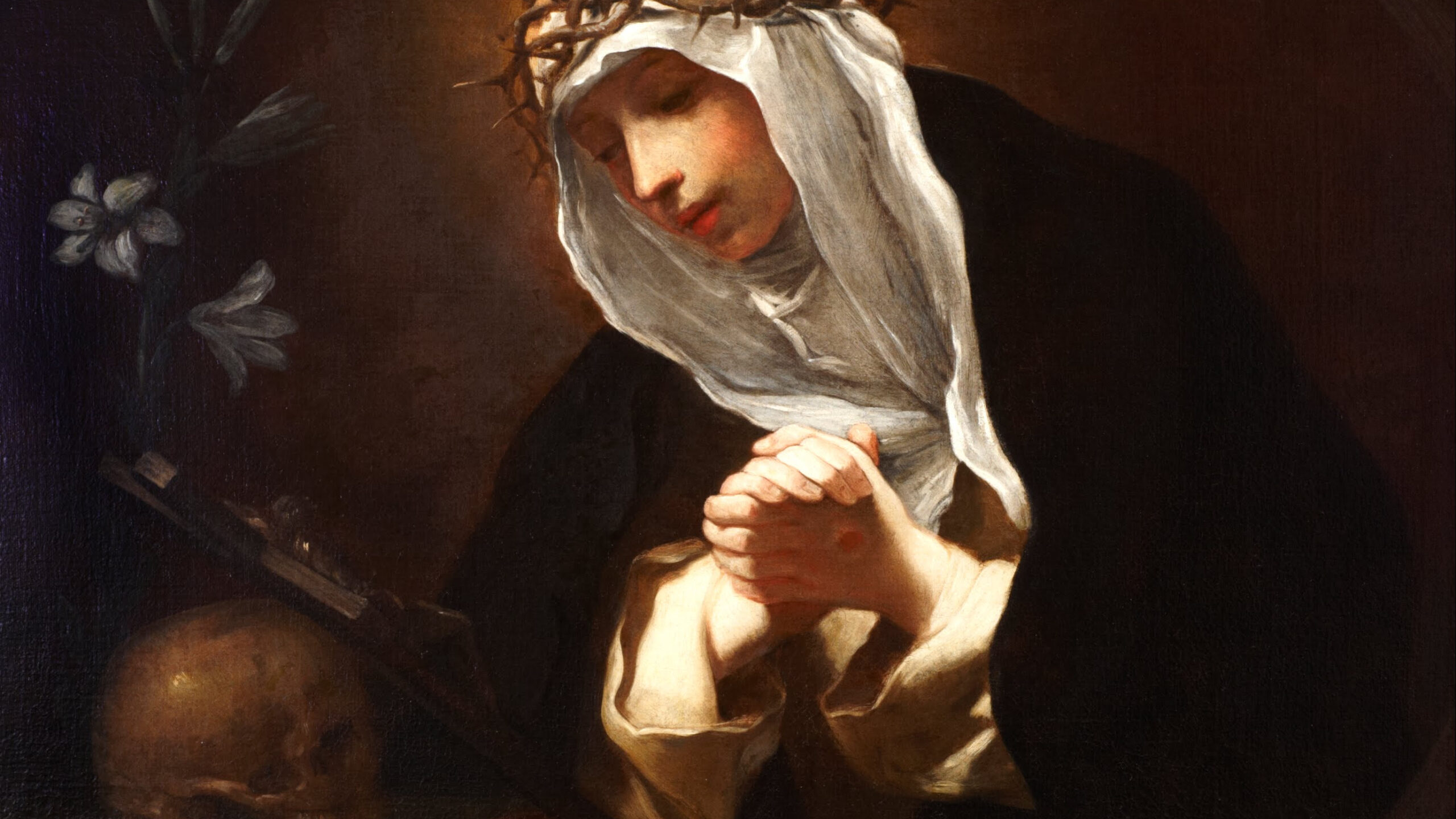We all benefit from good role models to show us the right path and inspire us to venture it to the end. Saints do this by the light of their life, teaching us how to walk day-to-day with Christ within the reality of our everyday circumstances. In addition to this, saints bestowed with the title Doctor of the Church have each shed new light on divine revelation in their teachings, which the Church deems as having significant and perennial value. Therefore, if you are looking for guidance on how to live as a disciple of Christ in our strange times, look to St. Catherine of Siena, both a saint and a Doctor of the Church, whose feast day is April 29. The breadth of her life and teachings could fill a tome, but here are four takeaways for us today.
We are Forged in Communion
No man is an island but rather part of a web of interconnections and interdependencies. Catherine’s life is a spectacular example of this. Her formative years were influenced by the Dominicans whose church and cloister were just up the hill from her home. They would not only nurture her inner desire for learning and teaching about God but also remain at the center of future friendships and relationships of importance to her. Her first confessor and spiritual director, Tomaso della Fonte, was not only a Dominican friar there but also the brother of her brother-in-law, with whom she had even grown up as a child when her family took him in after he was orphaned due to the plague.
The early trials Catherine endured during the testing of her faith came through arguments with her mother. Though she had extraordinary mystical experiences, Catherine had to live her relationship with Christ in the midst of everyday pressures, decisions, and discernment. For example, Catherine’s austere ascetic practices together with her intense prayer and solitude frustrated her mother who worried this would not exactly attract a marriage partner. Catherine was obstinately defiant of her mother’s will that she relax her penances a bit and attend to her appearance. Her angered mother changed strategies and turned to Catherine’s favorite sister, Bonaventura, to persuade her. This initially softened Catherine, and Bonaventura even convinced Catherine to style her hair in a trendy way. However, when Bonaventura died in childbirth shortly after, Catherine deeply regretted having given in and went to the opposite extreme of cutting her hair altogether to make herself even more unattractive to possible suitors. Her mother responded with equal temper and saddled her with so many household responsibilities that she could have no time for solitude. In equal retaliation, Catherine turned within and retreated to a solitude within her own soul while in the midst of the noise and work of a busy home. Finally, Catherine won the battle of wills between herself and her mother when her father intervened, and she was given a little room under the stairs in their house which she made into her own little religious cell.
Catherine purifies our prudence as we decide which road to take at each fork in the path.
Pope St. John Paul II called the family “the school of virtue.” Catherine’s fidelity to Christ’s call in prayer was both tested and strengthened through her everyday interactions with her family at home and her interactions with the Dominicans up the hill.
Finally, God’s calling for Catherine included becoming a third order Dominican, one of the Mantellate in Siena, which she had known growing up as they served the poor in her community. They wore the Dominican habit, and though they lived in their own homes, they acted under the direction of a prioress and the Dominican friars. However, all of them were widows. It was unheard of for a single, unmarried woman to join. Nevertheless, Catherine would eventually receive the Dominican habit as a tertiary, and become a source of inspiration for the very community that inspired her.
We Each Have a Purpose
Pope Benedict XVI emphasized the idea of being from and for in relation to our identification with Christ, the Son of God who came from the Father for us. He wrote:
To John, ‘Son’ means being from another; thus with this word he defines the being of this man as being from another and for others, as a being that is completely open on both sides, knows no reserved areas of the mere ‘I.’ . . . To John, being a Christian means being like the Son, becoming a son; that is, not standing on one’s own and in oneself, but living completely open in the ‘from’ and ‘toward.’
St. Catherine’s incredible union with Christ is most evident in her unlimited openness—consistently receiving from the Lord in prayer and her “inner cell,” and tirelessly responding with love toward Christ in the suffering poor, the fractious Church hierarchy, the warring Italian provinces, her spiritual children, and anyone whom she encountered.
We are easily tempted to envy and competitiveness, especially in our culture where comparison to both real and impossible standards seem ever present and inescapable. Catherine reminds us that we are different for a reason, and it’s to humbly receive from others and charitably give to others. In The Dialogue, Catherine articulates God’s providential and intentional design for this interdependency. The Lord tells her that he bestows different virtues and gifts upon people so that they need one another and can practice the highest virtue—charity.

Should we persist in the illusion of prideful self-reliance, God tells her that he has made communion an earthly necessity too, even for those who reject its eternal imperative.
Thus, that you may practice charity in action and in will, I in my providence did not give to any one person or to each individually the knowledge for doing everything necessary for human life. No, I gave something to one, something else to another, so that each one’s need would be a reason to have recourse to the other. So though you may lose your will for charity because of your wickedness, you will at least be forced by your own need to practice it in action.
Certainly today we can get around some of these restrictions the Lord put into place, more so than the medieval Sienese. Rather than ask a family member, neighbor, or colleague how to do something, we can quickly ask Google or YouTube instead. The intergenerational caretaking of the young and old can be provided by institutions. Even the mechanization of delivering products and providing services has added a degree of separation. As we all know, however, though we have seemingly gained greater independence from one another, we also feel overwhelming loneliness and disconnection. While we certainly don’t need to go back to living like medievals, we can learn from Catherine’s teaching to choose the personal interaction over the impersonal whenever possible. We sometimes resist interdependence because people can be difficult to work with. However, Catherine asserts that this is intentional by God’s design, that we may grow in love.
Stop Complaining and Start Contributing
A hazard of living in our consumer culture can be a tendency toward the role of passive reviewer rather than active renewer. Sinners are everywhere, but where are the saints? It’s time to rise up, baptized Christians! We each have a calling, a mission, a mandate from our Lord to sanctify the temporal world, and it’s essential that we each contribute the virtues and charisms the Lord gave us for its renewal. Yes, we live in dark and strange times. It can seem overwhelming and like nothing we do will make a difference. From health crises such as COVID-19, to Church infighting and scandals, to threat of cyber attacks or another world war, to the dark realities of human trafficking and the booming pornography industry. And yet, St. Catherine lived in very dark, strange times too. During her life was the Bubonic Plague, the Avignon papacy and later a schism and antipope, constant political and military threats within the provinces of Italy, and the sordid sins of individuals in Siena and beyond.
We can learn from Catherine—by her example and teaching—how to rise up and step up as members of the Church Militant in this ongoing spiritual battle. First, she prayed. Her response to her mystical experiences was to draw near to the Lord, to learn from him and to love him. After finally becoming a third order Dominican, she spent the first three years not on the streets in action but in prayer and penance in her little room under the stairs. From that relationship with the Lord flowed forth the outward service for which she became famous.
A huge difficulty in contributing to the cause is persevering through setbacks, failures, and betrayals. Catherine suffered more than her fair share of these, repeatedly. She of all people could have given up, blaming her detractors and saboteurs. Instead, she demonstrated heroic hope, trusting the outcome to the Holy Spirit and divine providence, while she faithfully did her part.
Dominican theologian Fr. Garrigou-Lagrange’s description of this virtue aptly applies to St. Catherine:
Heroic hope manifests itself not only by its firmness, but by trusting abandonment to Providence and to the omnipotent goodness of God. Perfect abandonment differs from quietism because it is accompanied by hope and unwavering fidelity to duty, even in little things, from moment to moment.
He goes on to quote Catherine from The Dialogue, where she connects the fruit of hope to love. She speaks from experience that the more we surrender to the Lord, the more we will get to see and “taste” his divine providence at work.
St. Catherine lived in very dark, strange times too.
Once again, Catherine purifies our prudence as we decide which road to take at each fork in the path. When angered by a wrong, pray for it to be made right, and be ready to respond to the Lord’s call—whatever it may be. Don’t be discouraged at what seems to be a failure or when the result isn’t delivered shortly. Take the long view and focus on the mission that Christ has given you in the fight—ordinary or extraordinary.
Live in the Unity of Truth and Love
Many people pit truth and love against one another. Some use love as an excuse to brush aside God’s revealed truths and commandments. Others use truth as an excuse to shield themselves from the implications and messiness of compassion. St. Catherine loved Christ with her entire being. She wanted to know and love him, not something imagined or tainted by our fallen tendencies and assumptions. To keep our relationship with him truly relational and interpersonal, rather than one-sided, she repeatedly emphasized the unity of Truth and Love. When we confine Christ too much to our intellect, we can keep him from our heart. However, when we confine our faith to our feelings, we can obscure Christ with our own projections. Only in the union of divine Truth and Love is the power for true conversion and ultimately, union with God—the ultimate goal of the Christian life. Knowing and loving God is in fact the essence of heaven. Even mysticism is simply union with the Lord who loves us and asks for love in return. Through the extraordinary mystical experiences of St. Catherine, God teaches us just how incredible his desire is for us and how passionate our desire can be in return.
St. Catherine of Siena was someone whose heart was on fire for the Lord, and in turn set the world on fire in the midst of times no less strange and difficult as our own. The takeaway for us is to step forward in humility, knowing our limitations, while placing our hope in the loving providence of God. Before we calculate our next move, ask Christ for his input—it may surprise us, but he’ll provide.
St. Catherine, pray for us!
